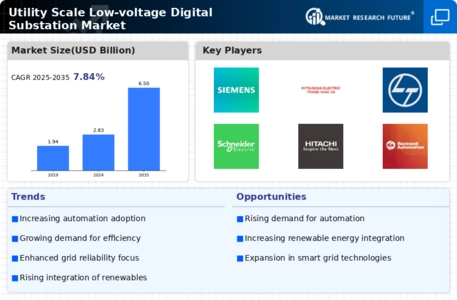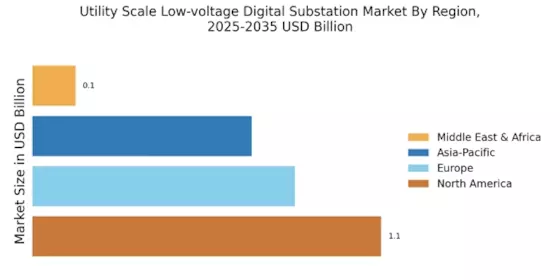Rising Demand for Renewable Energy
The rising demand for renewable energy sources is a key driver influencing the Utility Scale Low-voltage Digital Substation Market. As countries strive to meet sustainability goals, the integration of solar, wind, and other renewable sources into the energy mix is becoming increasingly prevalent. This shift necessitates the development of advanced substations capable of handling variable energy inputs. According to recent data, investments in renewable energy infrastructure are expected to surpass several trillion dollars over the next decade. Consequently, the need for low-voltage digital substations that can efficiently manage these resources is anticipated to grow, thereby propelling market expansion.
Increased Focus on Energy Efficiency
An increased focus on energy efficiency is emerging as a significant driver for the Utility Scale Low-voltage Digital Substation Market. As energy costs rise and environmental concerns grow, utilities are under pressure to optimize their operations and reduce waste. Low-voltage digital substations offer enhanced monitoring and control capabilities, enabling utilities to improve their energy efficiency. Recent studies indicate that investments in energy-efficient technologies can yield substantial savings over time. Consequently, the demand for digital substations that facilitate energy-efficient practices is likely to rise, contributing to the overall growth of the market.
Government Initiatives and Incentives
Government initiatives and incentives play a crucial role in shaping the Utility Scale Low-voltage Digital Substation Market. Many governments are implementing policies aimed at promoting energy efficiency and the adoption of digital technologies in substations. These initiatives often include financial incentives, grants, and regulatory support for utilities to upgrade their infrastructure. For instance, various countries have set ambitious targets for reducing carbon emissions, which necessitates the modernization of electrical grids. As a result, the market for low-voltage digital substations is likely to benefit from these supportive measures, fostering innovation and investment in the sector.
Integration of Smart Grid Technologies
The integration of smart grid technologies is a pivotal driver for the Utility Scale Low-voltage Digital Substation Market. Smart grids facilitate real-time monitoring and management of electricity flows, enhancing the efficiency of energy distribution. This integration allows for better demand response and load management, which is crucial as energy consumption patterns evolve. The market for smart grid technologies is projected to grow significantly, with investments expected to reach billions in the coming years. As utilities adopt these technologies, the demand for low-voltage digital substations is likely to increase, as they are essential for managing distributed energy resources and ensuring grid stability.
Technological Advancements in Substation Design
Technological advancements in substation design are significantly influencing the Utility Scale Low-voltage Digital Substation Market. Innovations such as modular designs, advanced materials, and digital monitoring systems are enhancing the efficiency and reliability of substations. These advancements allow for quicker installation and reduced operational costs, making low-voltage digital substations more attractive to utilities. Furthermore, the adoption of digital twin technology enables real-time simulations and predictive maintenance, which can lead to improved performance and reduced downtime. As these technologies continue to evolve, they are expected to drive the demand for modern substations, thereby expanding the market.


















Leave a Comment